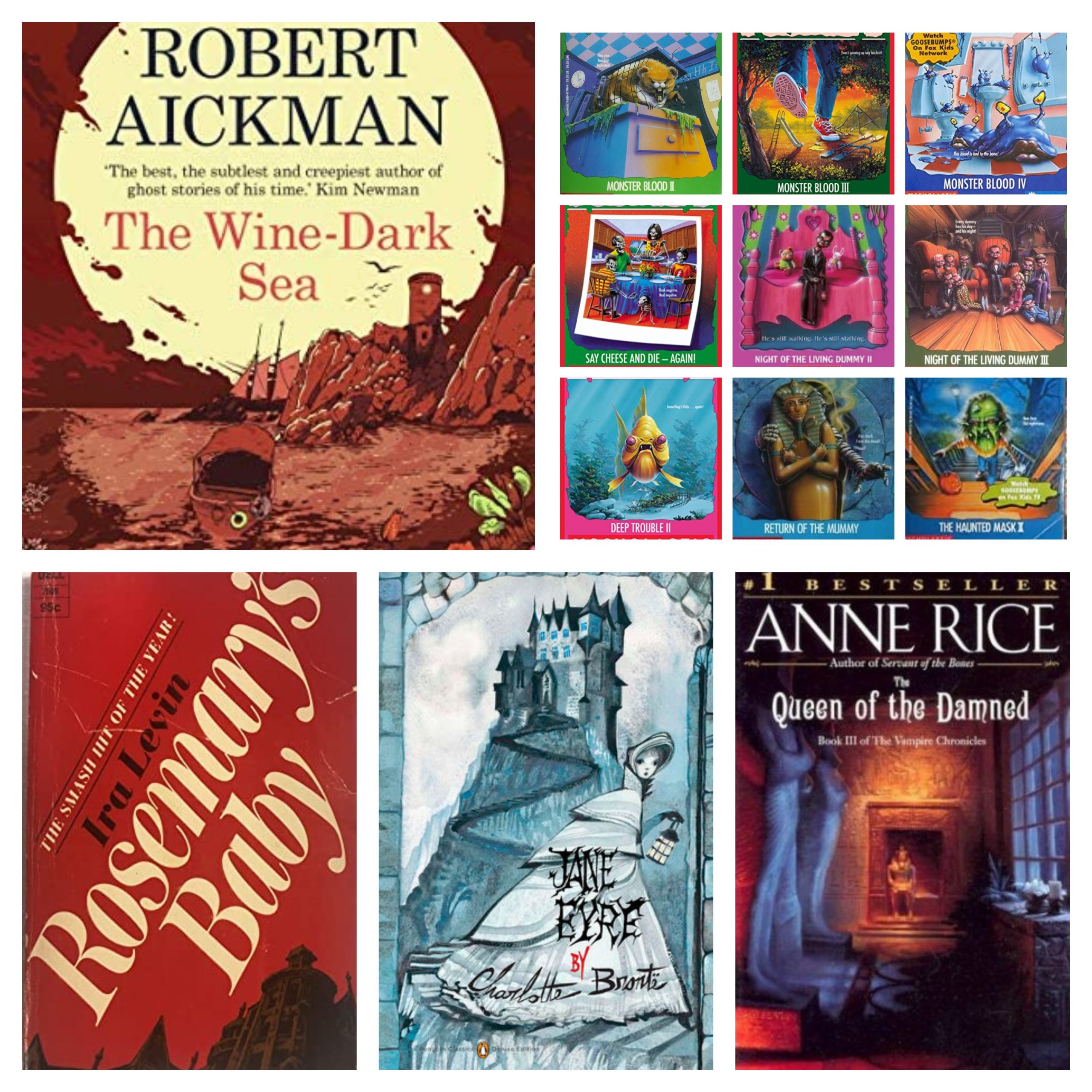I’m back again after a break for Thanksgiving and to give our annual gift guide some time to breathe! In this group of macabre offerings, I tackle a couple of great collections from a master of the horror short story, a pile of Goosebumps sequels, one of the all-time classic horror novels, a gothic novel of dark secrets and the third in THE long-running sexy vampire franchise.
For those just joining me, this is my journey through the following “Best of” Horror lists:
Reedsy Discovery Best Horror Books
Stephen Jones & Kim Newman’s Horror: 100 Best Books
Stephen Jones & Kim Newman Horror: Another 100 Books
If you want to check out my previous entries, they can be found here:
Part 32 | Part 31 | Part 30 | Part 29 | Part 28 | Part 27 | Part 26 | Part 25 | Part 24 | Part 23 | Part 22 | Part 21 | Part 20 | Part 19 | Part 18 | Part 17 | Part 16 | Part 15 | Part 14 | Part 13 | Part 12 | Part 11 | Part 10 | Part 9 | Part 8 | Part 7 | Part 6 |Part 5 | Part 4 | Part 3 | Part 2 | Part 1
It’s getting cold outside, so whip up some hot chocolate and join me by the cozy fire to bask in the glow of some haunted happenings.
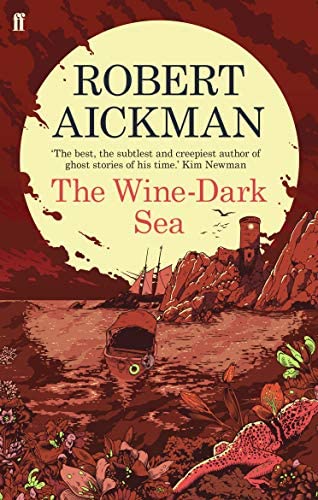
The Unsettled Dust/The Wine-Dark Sea (Robert Aickman, 1988-1990)
List: Jones/Newman (These two collections include all stories included in the previously published Aickman collection Sub Rosa: Strange Tales in addition to several stories not collected there.)
Robert Aickman is an author who I’ve always appreciate but never quite warmed up to for some reasons. He has such a subtlety to his writing that you almost don’t realize how creepy his stories are until you find them clinging to the back of your brain days later. His stories are often very weird and somewhat ambiguous in their interpretations with beautiful and delicate prose and a grounded sense of character. One can see his influence on the likes of Thomas Ligotti and Ramsey Campbell for sure.
Starting with The Unsettled Dust, the first two stories, the title story and “The House of the Russians” are both fairly straightforward ghost stories, and I would argue they may not actually be the best introduction to Aickman quite frankly. They are decent stories but not terribly memorable. The dark psychological story “No Stronger Than A Flower” is certainly an improvement and for sheer non-sequitur weirdness, “The Ciccerones” and “The Next Glade” work pretty well even if they don’t necessarily make sense. “Ravissante” was a solid one that reminded me a little of the similar tortured artist story by David Morrel in Prime Evil, and “Bind Your Hair” was an interesting folk horror story that certainly left an impression. Taking up a big chunk of the collection is the final story, or really more novella, “The Stains”, a kind of dark, weird fairy tale fueled by an undercurrent of sexual terror. Honestly this had a lot of things going for it, but it did feel entirely too long for my tastes. Over all, this first collection was a little uneven but overall still worth checking out.
The Wine-Dark Sea, on the other hand, I enjoyed almost entirely front to back. From the bizarre folk horror of the title story to the increasingly unsettling “Your Tiny Hand is Frozen”, there are lots of good stories here. “The Trains” is one in particular that felt very fresh and contemporary to me, the story equivalent of cautionary tales of oddball country folk like Texas Chainsaw Massacre and Tourist Trap. “The Fetch” is a solid tale of a generational curse spawned forth from the sea, and “The Inner Room” is an excellent and haunting story of a dollhouse, a kind of inversion of M. R. James’ “The Haunted Doll’s House” in some ways. “Into the Woods” was a good character piece even though I felt it was a little predictable for Aickman. Really the weakest story for me was “Never Visit Venice”. I just found it really hard to relate to this on any level and the ending just doesn’t feel satisfying to me. Overall though, The Wine-Dark Sea is a great collection well worth checking out.
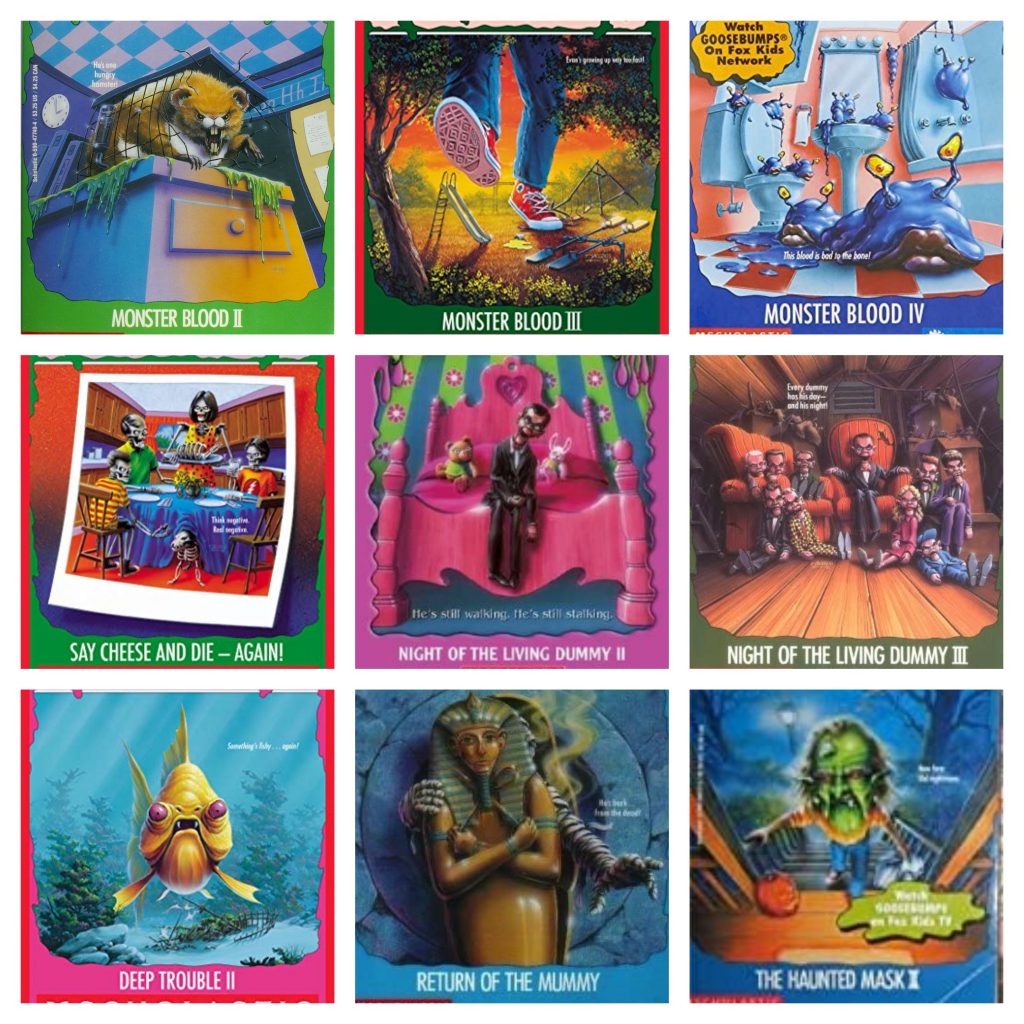
Goosebumps Round-Up #5: SEQUEL-PALOOZA
R. L. Stine never shies away from a story he can cash in on by churn out a sequel or two (or three). From what I remember when I was a kid, these sequels were some of the laziest of the original 62 books of Goosebumps. As such, I decided to tear off the Band-Aid and plow through all of them at once.
Monster Blood II: The kids from the first Monster Blood book are back and for some stupid reason decide to dredge up that problematic goo once again. This time they end up feeding a hamster and causing it to grow massive rampaging through town. Gone are the allusions to the blob, instead becoming more of a kaiju story. It’s not terribly good or original. Makes me wonder why/how they made two more of these (technically more if you include the spin-off series’).
Monster Blood III: Well, Evan, the idiot kid from the first two books, is back again. This time he accidentally ingests monster blood himself while trying to teach his annoying cousin a lesson and grows giant. Cue a Honey, I Blew Up the Kid rip-off. This series is surely running on fumes…
Monster IV: Dumb ol’ Evan is back yet again. This time screwin’ around with a special BLUE monster blood that spawns little self-replicating slug creatures that seem pretty benign but kinda annoying.
Say Cheese and Die Again: The plot to this is beyond stupid. Greg from the first book and his friends narrowly escaped almost certain disaster with a clearly deadly camera, and the second book starts with his mean teacher giving him a bad grade on an oral report where he’s supposed to tell a true story about himself. Greg, like a dumbass, tells the story of the evil camera, so of course he gets laughed at and fails. His teacher refuses to change his grade unless he can prove his story is true. So of course Greg tracks down the evil camera out of the garbage, again, LIKE A DUMBASS. This time the camera has some bizarre properties where it causes Greg and his friend to start gaining and losing tons of weight respectively. This completely eliminates the only vaguely interesting thing about the first book on the ambiguity of whether the camera predicts the future or actively causes bad things.
Night of the Living Dummy II: This is basically just a carbon copy of the first book with different kids. “I didn’t do it! The doll did!” “Young lady, stop lying and go to your room!” Rinse. Repeat. Bleh.
Night of the Living Dummy III: This one, like the previous book is also pretty much the same as the first book, this time re-incorporating the mis-direction of a different evil dummy. Except of course, this is part 3, so the “twist” comes as no surprise to anyone.
Deep Trouble II: Well, at least this has the decency to not recycle the plot of the first book like most of these. Instead it just steals the plot of Monster Blood II instead with giant fish instead of a hamster.
Return of the Mummy: I guess this one is for those who read the first book and wished it got to the mummies faster. This one actually delivers the kind of mummy plot I would actually expect. It’s not bad as far as a Goosebumps take on a Universal monster classic.
The Haunted Mask II: Yet another lazy sequel that basically just recycles the plot of the first book, except dumber. This time, the jerk kid that liked playing jokes on the protagonist of the first book is the lead here. He wants to get revenge on the girl that scared him with that totally awesome mask and wants his own creepy mask. So he goes to the same place, steals a mask, gets it stuck on his head, etc. Except this time instead of turning him into a hideous monster, it turns him into a decrepit old man with spiders in his hair, which plays out as stupid as it sounds.
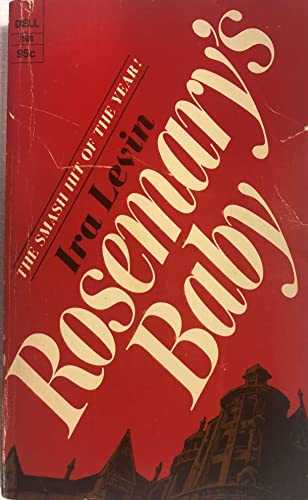
Rosemary’s Baby (Ira Levin, 1967)
List: Jones/Newman and NPR
Rosemary Woodhouse and her husband Guy moves into an old but decadently gothic apartment building after which they meet their eccentric but seemingly harmless older neighbors Minnie and Roman who quickly worm themselves into Rosemary’s and Guy’s life. One evening Rosemary has nightmarish visions of being ravished in a beastly fashion by some sort of monster while mysterious robed people surround her, the next day waking up with scratches on her body that her husband writes off as getting a little too feisty in the sack. Before long Rosemary is pregnant and in a lot of pain, but her doctor, recommended by Minnie & Roman, doesn’t see a problem and leaves Rosemary to suffer in silence. To make matters worse, a close friend of the Woodhouse’s an older man named Hutch becomes deathly ill after sending Rosemary a cryptic warning about the situation she finds herself in. As Rosemary’s paranoia grows, she struggles to determine whether it’s all in her mind or if there truly is some devilish conspiracy afoot.
To be honest, I feel a little foolish summarizing this one given it’s by far one of the most famous novels on the list with the title itself becoming shorthand for giving birth to the antichrist in pop culture. It’s also really strange that somehow I’ve never read this either. It was actually one of the few genre fiction novels that my mom owned when I was growing up (along with The Stepford Wives and Stephen King’s Christine, both of which I did read). Of course, I’ve seen the film, and I was surprised to find just how faithful the movie version was to the book. The film is almost word-for-word, beat-for-story beat. The only significant scene I remember being excluded from the film was a section after Rosemary’s hellish Satan rape where she goes to a cabin in the woods for a weekend to get away from Guy and think about their relationship since he admitted to basically having sex with her non-consensually while she was asleep. I understand why it was left out though since it’s a very internal scene that wouldn’t have been very filmic. And in general, that’s where the differences are, with the book giving more of Rosemary’s internal thoughts and feelings. Overall, it’s a well-paced and quick read, and I can see why it was such a huge success at the time. I’m sure the ending offered lots to talk about over the water cooler. I enjoyed it while it lasted, but Levin’s clean prose feels almost too basic at times.
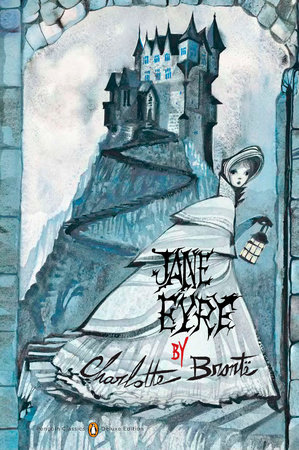
Jane Eyre (Charlotte Brontë, 1847)
List: Jones/Newman
Jane Eyre is a willful and spirited girl who, after a troubled childhood, is hired by the stern and brooding Edward Rochester to act as governess for his ward Adèle at the imposing and ornate gothic estate of Thornfield Hall. But as Jane falls in love with Edward Rochester, mysterious and strange occurrences happen at an increasing frequency. Edward is harboring a dark secret that he does not want to reveal, a dark past that will come back to haunt both he and Jane for some time to come.
I’m sure many see this and think “why is Jane Eyre on a horror list?” and while it definitely is not horror in the traditional sense with no supernatural spirits at play, it is very much a tried and true example of Victorian gothic literature that was such a large influence on horror of the late 19th century. Interestingly the structure of the novel isn’t necessarily structured entirely around Jane’s relationship with Edward Rochester. In fact, that aspect of the plot doesn’t really even come into the picture until about a third of the way through the book. Instead, as the title would imply, the story is more about Jane and her strength and resilience of character. Jane is, even by modern standards, not a traditional heroine (in fact it seems like literature is just now catching up to the broad-thinking, independent attitude that Jane exudes throughout the novel). While she does fall for Edward Rochester, this is not the sole driving force in her life. In the final third of the book, we see Jane set out to find herself after Rochester’s big secret is revealed, choosing to make a life for herself through honest work and honest living rather than live as a disrespected mistress. One other interesting aspect of this novel that gives it more of a grounding is that neither Jane nor Edward are classically beautiful. Jane is described many times as rather plain-looking, unremarkable, and at no point does the novel try to gussy her up for her prince. Rochester is described as rough-looking at craggy, not traditionally handsome at all. In fact, the primary character that is described as classically handsome turns out to be a self-centered and belligerent religious nut that Jane rightfully spurns.
Speaking on the gothic aspects of the story, the middle portion of the novel is where much of these references lie. The gloomy and oppressive descriptions of Thornfield Hall itself, the strange sounds in the night, an attempted murder by bed burning, buried secrets from the past, madness, etc. It really does have all the classical trappings of what one thinks of when gothic literature is discussed, and Brontë is able to spin some lushly grim prose that carries throughout this section of the story. Overall, while I’m not the biggest fan of Victorian literature, I do recognize that this is an elegantly written and forward thinking example of the genre, and one that I actually appreciated quite a bit. I certainly liked it much more than Pride & Prejudice which just feels like fluff in comparison.
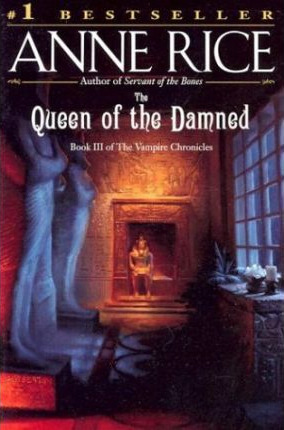
The Queen of the Damned (Anne Rice, 1988)
List: NPR
In this third book in the Vampire Chronicles, we find our old pal Lestat full of humble-brags and still rocking with his band, having just released a tell-all book that essentially is the previous book the series, much like Interview with the Vampire was referenced as a book released with this world during the course of the second book. And speaking of Interview with the Vampire, we also meet up with the author of said interview, Daniel, who is now being brought into the vampiric fold himself along with a young researcher of the occult named Jessica. We also catch up with old friends like Armand, Marius, Louis (the vampire interviewed in the first book) and several others who begin to form a kind of coven, troubled by dreams of red-haired twins and the titular queen of the vampires, who is being reawakened as a result of Lestat’s kickin’ tunes. Will the queen get her way and eradicate nearly the entire human male population of the entire planet or can she be stopped? Only by delving into the past of where it all began, can the vampires move forward.
So if you’ve been following this series of write-ups I’ve been doing on these horror novel lists, you might remember that I was pretty lukewarm on the previous two entries in Rice’s Vampire Chronicles, feeling like they were more just an episodic series of extravagant adventures interspersed with some serious moping. Well, this book is kinda more of the same. There are elements of it that I actually liked though. I liked Jessica as a character until the book basically sidelined and ignored her for the back half of the novel. I thought the big concert scene was well executed although it felt like a climax that occurs too early, essentially acting as a divider between the two halves of the book, the coming of the queen and the arrival of the queen. Speaking of the queen, the story of the twins and the queen was actually pretty well done but the book didn’t really seem to capitalize on what to do after it was over, resulting in an extremely anti-climactic ending. The first quarter of the book was also not terribly engaging, spending far too much time on Armand waxing philosophic and moping. Overall, this book was kind of a mess with a few interesting ideas but not enough for me to read any more of these (especially since I’ve heard they continue to get worse after this).

